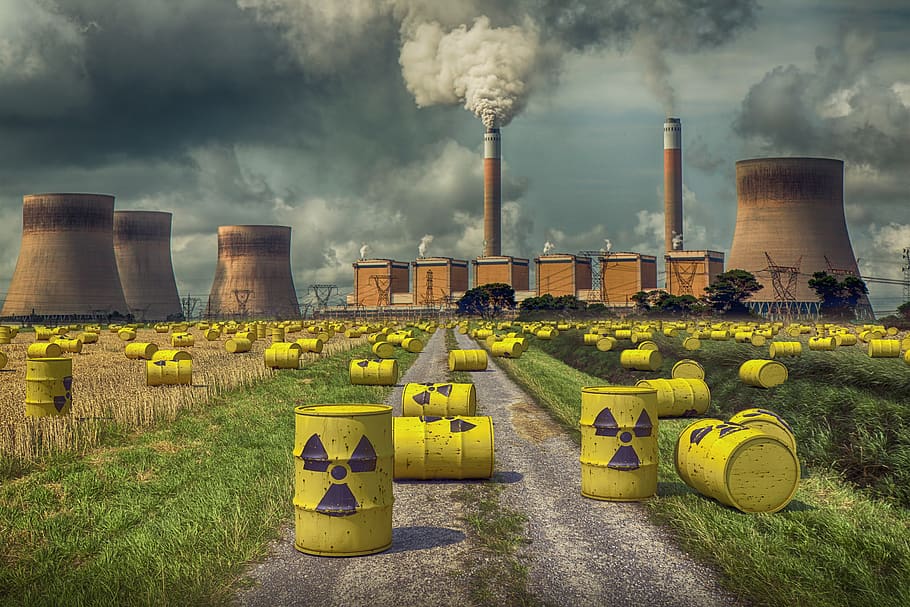Weekly News Roundup 27/08/23
- News
- August 27, 2023

A nuclear meltdown is a catastrophic failure of a nuclear reactor that results in the release of dangerous levels of radiation into the environment. It occurs when the reactor’s core, which contains nuclear fuel such as uranium or plutonium, overheats and begins to melt, causing a loss of control over the nuclear chain reaction.
The stages of a nuclear meltdown typically include an initial problem or malfunction within the reactor, followed by a rapid increase in temperature and pressure, leading to a partial or complete failure of the reactor’s cooling system. This can cause the fuel rods to heat up and melt, leading to the release of radioactive material into the surrounding area.
There have been several high-profile nuclear meltdowns in history, such as the infamous Chernobyl disaster in 1986, the Three Mile Island accident in 1979, and the Fukushima Daiichi nuclear disaster in 2011. These events have had devastating effects on the environment and human health, and serve as a reminder of the potential dangers of nuclear energy.
Preppers and survivalists in the UK should be aware of the risks associated with nuclear meltdowns and take necessary precautions to protect themselves in the event of such a disaster. This may include stockpiling supplies such as food, water, and medical equipment, as well as having a plan in place for evacuation or sheltering in place. It is also important for preppers to stay informed about updates and developments regarding nuclear facilities and reactors, as well as any potential threats or attacks on such facilities.
While the likelihood of a nuclear meltdown in the UK may be low, it is not impossible. The country currently has 15 operational nuclear reactors, all of which are regulated by the Office for Nuclear Regulation (ONR) to ensure their safe operation. However, accidents and disasters can still occur, and it is important for preppers and survivalists to be aware of the risks associated with nuclear facilities.
One of the most famous nuclear meltdowns in history occurred at the Chernobyl nuclear power plant in Ukraine in 1986, which resulted in the release of large amounts of radioactive material into the environment. While this event was caused by a combination of human error and design flaws in the reactor, it serves as a reminder of the potential dangers of nuclear energy and the importance of safety measures.
In the UK, the likelihood of a nuclear meltdown may be increased by the possibility of a terrorist attack or other intentional sabotage on a nuclear facility. This is a concern shared by many experts in the field of nuclear security, who warn that such an attack could have devastating consequences.
There have also been several near-miss incidents at UK nuclear facilities in the past. In 1957, a fire broke out at the Windscale nuclear reactor in Cumbria, resulting in a partial meltdown and the release of radioactive material. The incident was contained and did not result in any fatalities, but it served as a wake-up call for the nuclear industry and led to increased safety measures.
In 2012, a report by the ONR highlighted a number of safety concerns at the Sellafield nuclear plant in Cumbria, which included the risk of a major accident due to inadequate safety measures. While improvements have been made since then, the incident serves as a reminder of the ongoing risks associated with nuclear facilities.
Preppers and survivalists in the UK should therefore take the possibility of a nuclear meltdown seriously and be prepared to protect themselves in the event of such a disaster. This may include having a well-stocked bug-out bag, creating a plan for evacuation or sheltering in place, and staying informed about updates and developments related to nuclear facilities.
It is also important for preppers to educate themselves about the stages of a nuclear meltdown and how to protect themselves from the dangers of radioactive fallout. This may include understanding the importance of distance and shielding from the source of radiation, as well as the use of protective gear such as respirators and radiation suits.
Ultimately, while the likelihood of a nuclear meltdown in the UK may be low, it is important for preppers and survivalists to be aware of the risks and take necessary precautions to protect themselves and their families in the event of a disaster.
Contrary to popular belief, nuclear meltdowns do not necessarily result in explosions. While explosions can occur in certain circumstances, such as the hydrogen explosion that occurred during the Fukushima Daiichi nuclear disaster in 2011, they are not an inherent part of a nuclear meltdown.
A nuclear meltdown occurs when the fuel rods in a nuclear reactor overheat and melt, releasing radioactive material into the surrounding environment. This can lead to the release of harmful radiation, which can have serious health effects on both humans and the environment.
While a meltdown itself does not typically result in an explosion, there are certain circumstances that can increase the risk of an explosion occurring. For example, if the reactor’s cooling system fails and the fuel rods become exposed to air, they can react with water vapor in the air, producing hydrogen gas. If this gas accumulates and is not properly vented, it can ignite and cause an explosion.
In the case of the Chernobyl disaster in 1986, the explosion that occurred was caused by a combination of factors, including a design flaw in the reactor and human error. The explosion released large amounts of radioactive material into the environment and resulted in numerous deaths and long-term health effects.
In summary, nuclear meltdowns do not necessarily result in explosions. While explosions can occur in certain circumstances, they are not an inherent part of a nuclear meltdown.

A nuclear meltdown occurs when the fuel rods in a nuclear reactor overheat and melt, leading to a loss of control over the nuclear chain reaction. This can result in the release of dangerous levels of radiation into the surrounding environment and poses a significant threat to human health and safety.
The stages of a nuclear meltdown typically include an initial problem or malfunction within the reactor, followed by a rapid increase in temperature and pressure, leading to a partial or complete failure of the reactor’s cooling system. This can cause the fuel rods to heat up and melt, releasing radioactive material into the surrounding area.
During the initial stages of a meltdown, the reactor’s control rods, which are used to regulate the nuclear chain reaction, may be inserted to try and slow down or stop the reaction. However, if the temperature and pressure continue to rise, the fuel rods may begin to deform and release radioactive gases.
As the meltdown progresses, the fuel rods can melt and fuse together, forming a molten mass known as corium. This corium can then melt through the bottom of the reactor vessel and potentially penetrate the containment structure, releasing large amounts of radioactive material into the environment.
The release of radioactive material can pose a significant threat to human health and safety, depending on the amount and type of material released, as well as the proximity of individuals to the release site. Exposure to high levels of radiation can lead to radiation sickness, which can cause nausea, vomiting, and diarrhea, as well as long-term health effects such as an increased risk of cancer.
In addition to the direct health effects of a nuclear meltdown, the release of radioactive material can also have a significant impact on the environment. Radioactive material can contaminate soil, water, and air, leading to long-term environmental damage.
It is also important for preppers to understand the importance of distance and shielding from sources of radiation, as well as the use of protective gear such as respirators and radiation suits. Additionally, preppers should stay informed about updates and developments related to nuclear facilities and reactors, as well as any potential threats or attacks on such facilities.
Nuclear meltdowns are dangerous because they can release large amounts of radiation into the surrounding environment, posing a significant threat to human health and safety. The release of radiation can cause both short-term and long-term health effects, depending on the level of exposure and the type of radiation.
Exposure to high levels of radiation can cause radiation sickness, which can include symptoms such as nausea, vomiting, and diarrhea, as well as long-term health effects such as an increased risk of cancer. The severity of radiation sickness depends on the dose and type of radiation, as well as the duration of exposure.
In addition to the direct health effects of radiation exposure, nuclear meltdowns can also have a significant impact on the environment. Radioactive material can contaminate soil, water, and air, leading to long-term environmental damage. This can also have a ripple effect on ecosystems and wildlife, potentially causing harm to the food chain and biodiversity.
Furthermore, nuclear meltdowns can also have a significant impact on social and economic systems. The evacuation and displacement of affected populations can lead to disruption of daily life, as well as loss of property and assets. The cost of cleanup and recovery efforts can also be significant, potentially affecting local and national economies.

The question of whether nuclear energy is bad is a complex and controversial one. While nuclear energy has the potential to provide a significant source of clean energy, it also poses significant risks and challenges.
One of the main advantages of nuclear energy is that it produces a large amount of energy with a relatively small amount of fuel, without emitting greenhouse gases or other air pollutants. This makes it an attractive option for countries looking to reduce their carbon footprint and combat climate change.
However, nuclear energy also poses significant risks and challenges. Nuclear power plants require highly specialized and complex technology to operate safely, and accidents and meltdowns can have catastrophic consequences. Additionally, the storage and disposal of nuclear waste is a significant challenge, as the waste can remain radioactive for thousands of years.
Furthermore, the potential for nuclear energy to be used for military purposes, such as the production of nuclear weapons, is a significant concern. The development and proliferation of nuclear weapons pose a significant threat to global security and stability.
In addition to these concerns, nuclear energy is also expensive and can be politically contentious. The cost of building and operating nuclear power plants is high, and public opinion about the safety and feasibility of nuclear energy varies widely.
Overall, whether or not nuclear energy is bad depends on one’s perspective and values. While nuclear energy has the potential to provide a significant source of clean energy, it also poses significant risks and challenges. As with any source of energy, it is important to weigh the potential benefits against the potential risks and costs.
In the event of a nuclear meltdown in the UK, the potential impacts could be devastating. The release of radioactive material into the environment could have serious health effects on both humans and the environment, with the potential for long-term consequences.
The immediate effects of a nuclear meltdown would depend on the location and severity of the event. In the event of a partial or complete failure of the reactor’s cooling system, there could be a rapid increase in temperature and pressure within the reactor, potentially leading to a release of radioactive material into the surrounding area.
The release of radioactive material could have significant impacts on human health and safety. Exposure to high levels of radiation can cause radiation sickness, which can include symptoms such as nausea, vomiting, and diarrhea, as well as long-term health effects such as an increased risk of cancer.
Furthermore, the release of radioactive material could also contaminate soil, water, and air, leading to long-term environmental damage. This could have ripple effects on ecosystems and wildlife, potentially causing harm to the food chain and biodiversity.
In the event of a nuclear meltdown, the affected area could be evacuated and declared a no-go zone, with people being warned to stay indoors and avoid exposure to the radioactive material. This could have significant social and economic impacts, as people are displaced and daily life is disrupted.
Additionally, the cost of cleanup and recovery efforts could be significant, potentially affecting local and national economies. The effects of a nuclear meltdown could be felt for years or even decades, depending on the severity of the event and the effectiveness of cleanup and recovery efforts.
Ultimately, a nuclear meltdown in the UK would have serious and far-reaching consequences. While the likelihood of such an event may be low, it is important for preppers and survivalists to be aware of the risks and take necessary precautions to protect themselves and their families in the event of a disaster.

The signs of a nuclear meltdown can vary depending on the severity and location of the event, but there are several common indicators that can signal the onset of a nuclear meltdown. Here are five potential signs to look out for:
Preparing for a nuclear meltdown can be a daunting task, but taking necessary precautions can help protect you and your family in the event of a disaster. Here are some important steps to take to prepare for a nuclear meltdown:

A nuclear meltdown can have severe consequences for both humans and the environment. As the fuel rods inside a nuclear reactor begin to melt, the release of radioactive material can pose serious health risks to those in the surrounding area. The impacts of a nuclear meltdown can be far-reaching and long-lasting, affecting not only the immediate area but potentially the entire country and beyond.
One of the initial signs of a nuclear meltdown is an increase in pressure and temperature within the reactor. This can cause loud noises and vibrations as the reactor begins to fail. If the cooling system is not functioning properly, the temperature can rise quickly, potentially leading to a release of steam and gases from the reactor. These gases may contain radioactive material and can pose a risk to human health.
As the meltdown progresses, there may be a release of radioactive material into the environment. This can occur through the release of steam or gases, or through direct release of contaminated water or other materials. The radioactive material can travel through the air, water, or soil, potentially contaminating food sources, water supplies, and the environment.
The health effects of exposure to radioactive material can be serious and long-lasting. Radiation sickness can include symptoms such as nausea, vomiting, and diarrhea, as well as long-term health effects such as an increased risk of cancer. Children and pregnant women may be particularly vulnerable to the effects of radiation exposure.
In the event of a nuclear meltdown, authorities may issue evacuation orders or warnings to the surrounding area. This can cause significant disruptions to daily life, as people are forced to leave their homes and communities. The economic and social impacts of a nuclear meltdown can be severe and long-lasting, affecting not only the immediate area but potentially the entire country and beyond.
Cleanup and recovery efforts can take years or even decades, depending on the severity of the event and the effectiveness of the response. The cost of cleanup and recovery can be significant, potentially affecting local and national economies.
Preparation and prevention are key to minimizing the risks of a nuclear meltdown. Nuclear facilities must be designed and maintained with safety in mind, and regular inspections and maintenance can help prevent malfunctions and equipment failures. Emergency response plans must be in place and regularly updated, with clear communication channels and protocols for evacuation and response.
Individuals and communities can also take steps to prepare for a nuclear meltdown. Having a well-stocked supply of food, water, and medical supplies can help ensure that people have the resources they need to survive in the event of a disaster. Understanding the risks and potential health effects of radiation exposure can help people take necessary precautions to protect themselves and their families.
Ultimately, a nuclear meltdown can have devastating consequences for the environment, human health, and social and economic stability. By taking necessary precautions and being prepared, we can help minimize the potential impacts of a nuclear meltdown and ensure the safety and wellbeing of ourselves and our communities.
A nuclear meltdown can have serious hazards and impacts on individuals and society at large. Here are some of the main hazards of a nuclear meltdown:

During a nuclear meltdown, there are certain actions that you should avoid to minimize your risk of exposure to radiation and to ensure your safety. These are some things that you should avoid doing during a nuclear meltdown:
Preparing your home for a nuclear meltdown can help you and your family stay safe in the event of a nuclear disaster. Here are some steps that you can take to prepare your home for a nuclear meltdown:

A bunker can provide a safe and secure place for preppers to take shelter in the event of a nuclear meltdown. It can provide protection from radiation exposure and other potential hazards associated with a nuclear disaster. With the right design, materials, and NBC (nuclear, biological, chemical) filters, a bunker can provide a nearly impenetrable shield against radiation, fallout, and other contaminants.
The effectiveness of a bunker depends on its construction and the quality of its NBC filters. A well-designed and properly constructed bunker can provide a high degree of protection against radiation and other hazards associated with a nuclear disaster. NBC filters can help to remove radioactive particles from the air, providing a safe and breathable environment within the bunker.
While building a bunker can be expensive, it can be a worthwhile investment for preppers who are serious about preparing for a nuclear meltdown. A bunker can provide a long-term solution for sheltering in place and can help preppers survive in the aftermath of a nuclear disaster. With the right supplies and equipment, a bunker can also provide a comfortable and self-sufficient living environment for preppers and their families.
However, it is important to note that building a bunker is not a guarantee of safety. Preppers must carefully consider the location and construction of the bunker to ensure that it is safe and effective in the event of a disaster. They must also have the necessary supplies and equipment to survive for an extended period of time within the bunker.
In most cases, it is generally safer to “bug in” during a nuclear meltdown rather than to “bug out.” Bugging in involves staying in your home or sheltering in place, while bugging out involves leaving your home and moving to a different location.
Bugging in during a nuclear meltdown can be safer because it allows you to stay inside and shielded from the radioactive fallout. If you have prepared properly, you should have stocked up on essential supplies, have a plan for sheltering in place, and have a safe room or basement that can provide protection from radiation exposure.
In contrast, bugging out during a nuclear meltdown can be dangerous because it exposes you to radiation and other hazards outside of your home. It may also be difficult to find a safe and secure location to go to, and you may face significant challenges such as traffic congestion, road closures, and other obstacles.
Of course, there may be situations where bugging out is necessary, such as if you live very close to a nuclear facility or if your home is not properly equipped to shield you from radiation exposure. In such cases, it is important to have a well-prepared bug-out plan and to move quickly and safely to a designated safe location.
While there may be situations where bugging out is necessary during a nuclear meltdown, it is generally safer to bug in and stay inside your home or shelter in place. By preparing your home, stocking up on essential supplies, and having a safe room or basement, you can help ensure that you and your family stay safe in the event of a nuclear disaster.

The aftermath of a nuclear meltdown can be devastating and long-lasting. Depending on the severity of the disaster, it may take years or even decades for life to return to some semblance of normalcy.
One of the biggest challenges following a nuclear meltdown is the cleanup process. Radioactive material can contaminate soil, water, and air for miles around the site of the disaster. Cleanup efforts can involve removing contaminated soil, water, and debris, and disposing of them in a safe and secure manner. It may also involve decontaminating buildings and other structures and disposing of contaminated equipment and materials.
The cleanup process can be lengthy and expensive, and it may take years for the area to be fully cleaned up and safe for habitation. In the meantime, residents of the affected area may face significant challenges, including health risks from radiation exposure, displacement from their homes and communities, and economic hardship due to the disruption of businesses and services.
In addition to the physical and economic challenges, a nuclear meltdown can also have a significant psychological impact on those affected by the disaster. The fear and uncertainty associated with a nuclear disaster can have long-lasting effects on mental health, including anxiety, depression, and post-traumatic stress disorder.
It is important to note that the effects of a nuclear meltdown can extend far beyond the immediate area of the disaster. Fallout from a nuclear meltdown can spread for hundreds of miles, depending on the size and severity of the disaster. This can impact agriculture, wildlife, and natural resources, and can have ripple effects on the economy and social fabric of affected regions.




British Prepper is dedicated to bringing you the most useful information on a wide variety of prepper, survivalist and bushcraft related topics. We really hope that a major SHTF situation never strikes the United Kingdom, but as the old saying goes, failing to prepare is preparing to fail - so always be prepared!





